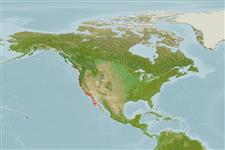>
Ovalentaria/misc (Various families in series Ovalentaria) >
Embiotocidae (Surfperches)
Etymology: Hyperprosopon: Greek, hyper = over + Greek, prosopon = face, snout of animal (Ref. 45335).
Environment: milieu / climate zone / djupintervall / distribution range
Ekologi
marina bottenlevande; djupintervall ? - 18 m (Ref. 2850). Subtropical; 52°N - 26°N, 130°W - 113°W
Eastern Pacific: Vancouver Island in British Columbia, Canada to central Baja California in Mexico, including Guadalupe Island (off northern central Baja California).
Size / Vikt / Age
Könsmognad: Lm ? range ? - ? cm
Max length : 30.0 cm TL hane/ej könsbestämd; (Ref. 2850); rapporterad maxålder: 6 år (Ref. 56049)
Short description
Bestämningsnycklar | Morfologi | Morfometri
Taggstrålar i ryggfenan (totalt) : 8 - 10; Mjukstrålar i ryggfenan (totalt) : 25 - 28; Taggstrålar i analfenan: 3; Mjukstrålar i analfenan: 30 - 35; Ryggkotor: 33 - 37. Dark blue dorsally, sides and belly silvery with young having narrow golden vertical bars; tips of pelvic fins black; dusky on edge of caudal fin (Ref. 6885).
Body shape (shape guide): short and / or deep.
Live in surf on sand beaches and over sand near rocks, often around piers. Often occur in dense schools. Feed on small crustaceans. Viviparous, female carries the developing young (Ref. 205). Usually bear 5-12 young. An important game species.
Viviparous, female carries the developing young (Ref. 205).
Eschmeyer, W.N., E.S. Herald and H. Hammann, 1983. A field guide to Pacific coast fishes of North America. Boston (MA, USA): Houghton Mifflin Company. xii+336 p. (Ref. 2850)
IUCN Red List Status (Ref. 130435: Version 2025-1)
Threat to humans
Harmless
Human uses
Fiskeri: kommersiell; sportfisk: ja
Verktyg
Special reports
Download XML
Internet-källor
Estimates based on models
Preferred temperature (Ref.
123201): 10.7 - 19, mean 12.8 °C (based on 115 cells).
Phylogenetic diversity index (Ref.
82804): PD
50 = 0.6250 [Uniqueness, from 0.5 = low to 2.0 = high].
Bayesian length-weight: a=0.01905 (0.00827 - 0.04391), b=2.97 (2.77 - 3.17), in cm total length, based on LWR estimates for this (Sub)family-body shape (Ref.
93245).
Trofisk nivå (Ref.
69278): 3.5 ±0.50 se; based on food items.
Resiliens (Ref.
120179): Mellan, lägsta populationsfördubblingstid 1,4-4,4 år (tm=1; tmax=6).
Fishing Vulnerability (Ref.
59153): Low vulnerability (20 of 100).
🛈
